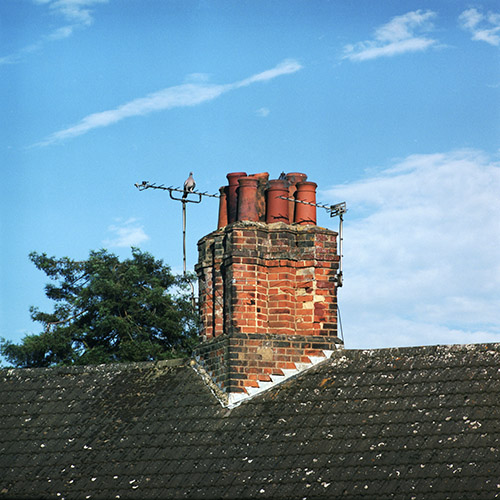The Pentacon Six
System
“Made in Germany”
The Pentacon Six (+TL) and its predecessor, the Praktisix, were made in Germany between 1956 and 1990, but throughout the whole of that period, Germany was a divided country, and the indication of country of origin on cameras and lenses was determined by political considerations.
For a map and a brief introduction to the historical background, see here.
The political background
When Germany was defeated in 1945 at the end of World War II, it was occupied by the four victorious powers and divided into four sectors, simply referred to (here in alphabetical order in English) as:
- the American Sector
- the British Sector
- the French Sector
- the Russian (or “Soviet”) Sector
Likewise, Berlin was divided into four sectors, even though it was located within the part of Germany that became the Soviet sector.
The Soviet Union rapidly imposed a communist economic and political system in the sector under its control and from 1949 onwards the Communist administration in the Soviet sector called its zone the “Deutsche Democratische Republik”. This was subsequently abbreviated on many products to “DDR”. The English translation of the full name would be the “German Democratic Republic”. However, it was of course not democratic at all, but a communist dictatorship, characterised by persecution and imprisonment of those who expressed opposition to the régime and even death for leading opponents.
Western countries normally referred to the “GDR” simply as “East Germany”.
Meanwhile, the other three sectors (the American, British and French zones) also reorganised politically, creating one State comprising regional German States (such as Bavaria, Schleswig-Holstein, etc). This State was given the name “Bundesrepublik Deutschland”, which was translated into English as the “German Federal Republic”. This part of Germany, which did not have the word “democratic” in its title, was in fact the only truly democratic part of Germany. However, western countries normally referred to it simply as “West Germany”.
Similarly, the American, British and French sectors of Berlin were eventually referred to by western countries as “West Berlin”, while the Soviet sector of Berlin was referred to in western countries as “East Berlin”. In the GDR itself, that eastern sector of Berlin was referred to as “Berlin Hauptstadt der DDR”, i.e., “Berlin, Capital City of the GDR”, a political statment spoken in a single breath with the description never omitted by anyone speaking in public in East Germany.
On this website, I do my best to disregard political matters, including those in Germany. However, the Praktisix and the Pentacon Six were manufactured in the “Russian Sector” or “Soviet Occupied Zone”, and so were most of the lenses that were manufactured for these cameras, and this is reflected in the name of country of origin on the items themselves and the literature about this system.
Three phases
We can distinguish three phases in the naming conventions used in “East Germany” between 1945 and 1990 to specify the country of origin of photographic goods and books produced in what was initially the Soviet sector:
- 1945-1961: made/printed in Germany
- 1961-1989: made/printed in the GDR/the German Democratic Republic (or “DDR”/“Deutsche Demokratische Republik”, in German)
- 1990: made/printed in Germany
Phase 1
Between 1945 and 1961, articles manufactured in any of the occupied sectors of Germany were usually marked “Germany” or “Made in Germany” or (for publications of any sort) “Printed in Germany”.
| Example from the
East German book “Fotografie mit der Praktica” by
Roger Rössing, 1959 edition |
|
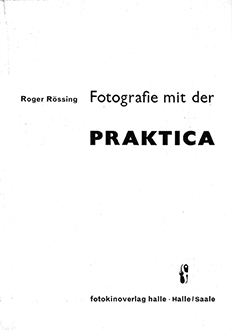 Rössing Title Page, 1959 [rsing59s.jpg] |
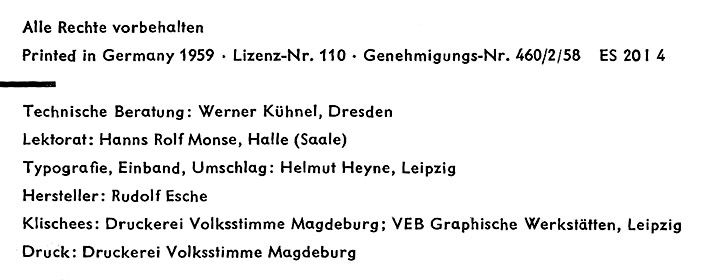 Rössing 1959 publishing details, enlarged. Note second line from top. [rsing59_2.jpg] These two images are not to the same scale. The page size in this book is approximately 21 cm high × 15 cm wide. |
As tensions rose, equipment imported from the Soviet zone into the USA was often stamped, perhaps by USA Customs officials, “USSR occupied” or “Soviet occupied”.
Phase 2
1961 saw a marked heightening of the “Cold War”, and on 13th August of that year the communist authorities in the Soviet sector of Germany and of Berlin cut off all exits from East Berlin to West Berlin, building the infamous Berlin Wall. They followed this up by building an armed and land-mined barrier along the whole of the demarcation line between the Soviet sector of the entire country, on their side, and the three “western” sectors of Germany on the other side. To attempt to cross the Berlin Wall or any other part of the wall/armed fence that they built was to invite, as a certain minimum, a lengthy prison term for those who were caught. Some were killed on the spot by being shot in the back by East German border guards as they tried to escape. (Those who wish to research this further will probably find plenty of information on the internet. Starting points might be a search for “Haus am Checkpoint Charlie”/“The Checkpoint Charlie Museum” or “Peter Fechter”.)
From this time on, the East German authorities insisted that all items from their sector be marked “DDR”, “Printed in the GDR/DDR” or “MADE IN THE GDR/DDR”.
| All
Pentacon Sixes and most of the East German
lenses for it were made during this period. |
| Example from the East German book “Pentacon Praxis” by Kurt Hartmann, 3rd (unchanged) reprint, 1961 | |
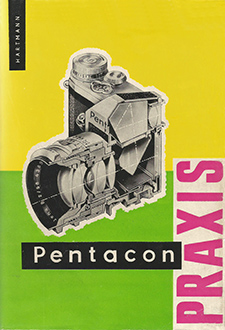 Hartmann Cover, 1961 [pntprx61_s.jpg] |
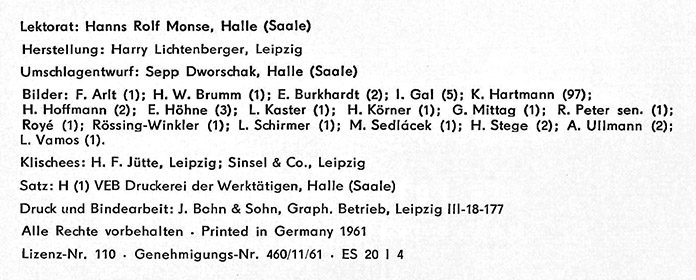 Hartmann publishing details, enlarged. Note second line from bottom [pntprx61_2.jpg] These two images are not to the same scale. The page size in this book is also approximately 21 cm high × 15 cm wide. |
| Books printed in
East Germany in 1961 that I have seen all state
“Printed in Germany”. We do not of course
know in which month of the year they were
printed. The Berlin Wall was built in August
1961, but we do not know in which month the East
German government took the decision to impose the
use of the term DDR/GDR/German Democratic Republic
for items manufactured in East Germany.
Perhaps a study of East German newspapers and
magazines published in 1961 might enable the exact
date of introduction of this rule to be
determined. |
|
| (Note that this book
makes no reference to the Pentacon Six. It
covers the post-war 35mm SLR camera from Dresden
that was originally marketed as the Contax
or “Contax S”.
See more details of that camera, starting here.) |
|
| Example from the East German book “Fotografie mit der Praktica” by Roger Rössing, 1962 edition | |
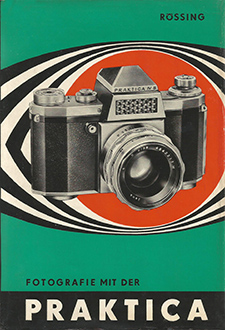 Rössing Cover, 1962 [rsing62s.jpg] |
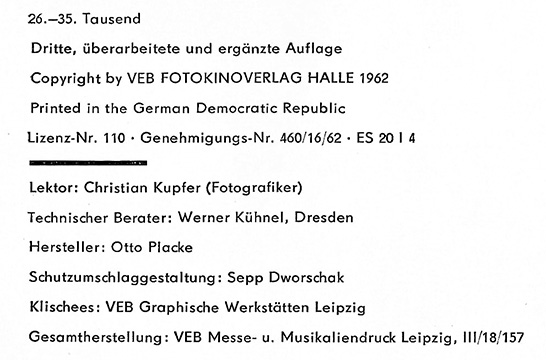 Rössing 1962 publishing details, enlarged. Note fourth line from top. [rsing59_2.jpg] These two images are not to the same scale. The page size in this book is also approximately 21 cm high × 15 cm wide. |
| All other books
printed in East Germany in 1962 or later that I
have seen state “Printed in the German Democratic
Republic”. |
|
Pictures of photographic items with the GDR or DDR labelling will be observed throughout this website, so on this page we are concentrating on items that were labelled differently from this.
MADE IN GERMANY (EAST)
In the late 1960s, some Pentacon Sixes exported to the USA were renamed “Hanimex Praktica 66”. (See details here.) It appears that it was the Pentacon factory itself that labelled these cameras “MADE IN GERMANY (EAST)”. Likewise, the Carl Zeiss 80mm Biometar lenses for these cameras were labelled “LENS MADE IN GERMANY (EAST)”. Some Pentacon Sixes and Biometar lenses for them manufactured in the late 1960s and exported to the USA were also similarly labelled.
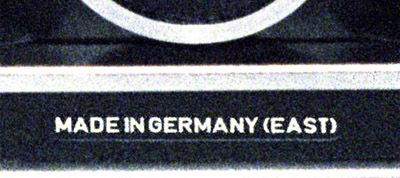 Base of Pentacon Six exported to the USA [C396_14body.jpg] |
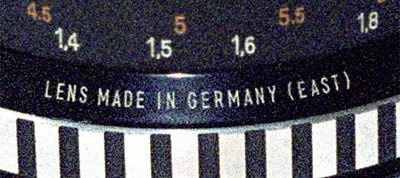 Carl Zeiss Jena Biometar lens exported to the USA [C396_14lens.jpg] |
| The camera and
lens shown in these photos can be seen here. |
|
Phase 3
In 1989, there were months of peaceful protests by citizens of the “GDR”, and thousands of “East Germans” fled to “West Germany” by travelling first to a fellow communist country, Hungary, to which they were allowed to travel. However, in the late summer of 1989, Hungary started dismantling its own repressive border installations, and allowing East Germans to travel to “western” countries. Then on 9th November 1989 the Berlin Wall was breached by some “East German” citizens. In the months that followed, both the political institutions and much of industry in “the GDR” crumbled.
At some point in 1990, possibly even before the reunification of the two Germanies on 3rd October 1990, some lenses for the Pentacon Six were produced with the designation “MADE IN GERMANY”. We shall look at some examples of some of these lenses on this page.
There were originally two East German companies that produced lenses for the Praktisix and the Pentacon Six:
- Carl Zeiss, Jena
- Meyer-Optik, Görlitz
As we have seen elsewhere (see here), after 1945 Carl Zeiss had manufacturing facilities – and, eventually, totally separate companies – in East Germany and in West Germany. After years of legal wrangling in various countries, they reached an out-of-court settlement (see here). They were both allowed to use the name “Zeiss” in specified countries, and not allowed to use the name “Zeiss” in certain other specified countries.
In fact, for certain export markets where the use of the name Carl Zeiss was not permitted, a new “aus Jena” lens ring was screwed on top of the original Carl Zeiss ring, so if you have a lens that is labelled “aus Jena”, it might be worth removing this name ring (if you have the right tool!), to check if the Zeiss ring is still there. You can see a picture of one such lens here. This practice was not company policy, but sometimes the new name ring was added by the importers in the destination country, and their technicians didn’t take the time needed to remove the original ring, instead just adding the new “aus Jena” export ring on top of it.
For the Pentacon Six, we are interested in lenses that were produced by Carl Zeiss in their original base, Jena, which was in East Germany. As indicated above, in the 1940s and 1950s, these were often labelled “GERMANY” or “MADE IN GERMANY”. From about 1961 they were usually labelled “DDR”.
However, some late-production Carl Zeiss Jena lenses for the Pentacon Six were marked “Made in Germany”. Here we shall look at one such lens.
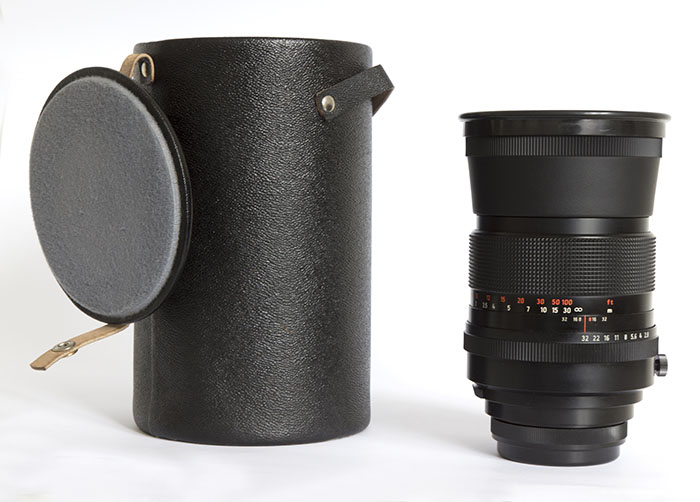 [gm180_01.jpg]
180mm Carl Zeiss Jena
Sonnar with Pentacon Six mount, as supplied,
with lens hood, front and rear caps and standard
“East German” lens case.
This looks like a standard Carl Zeiss Jena
“GDR” 180mm Sonnar, which for decades bore on the
name ring “DDR”. However, also in
one other detail it is different from the Carl
Zeiss Jena lenses for the Pentacon Six produced
since about the end of the 1970s until 1989 or
1990. Do you know what that other difference
is? (It is visible in this picture. Answer
below the next image) |
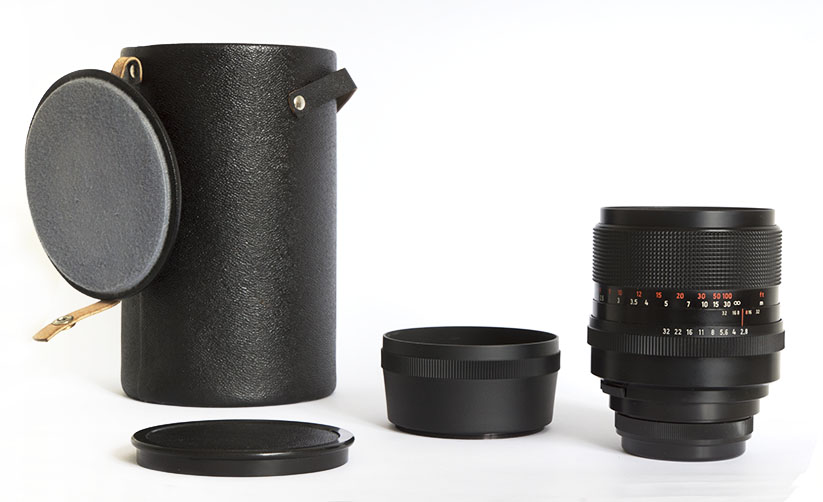 [gm180_02.jpg] The same lens, with the lens hood and front cap removed. The difference from the Sonnars supplied since the end of the 1970s? They only showed the distances in meters, the feet settings no longer being shown. Perhaps this indicated that these lenses were no longer being exported to countries that used feet and inches (principally the UK and the USA). The Pentacon Six was no longer being exported to those countries, but this lens also fitted (via an adapter) Praktica L series 35mm cameras that were still being exported, at least to the UK. In this 1990 or 1991 version, the feet settings re-appear, clearly indicating the desire to export the lens outside the former Soviet bloc countries. |
| Here is the same
lens, which is a Carl Zeiss Jena MC Sonnar f/2.8
180mm labelled “Made in Germany” |
||
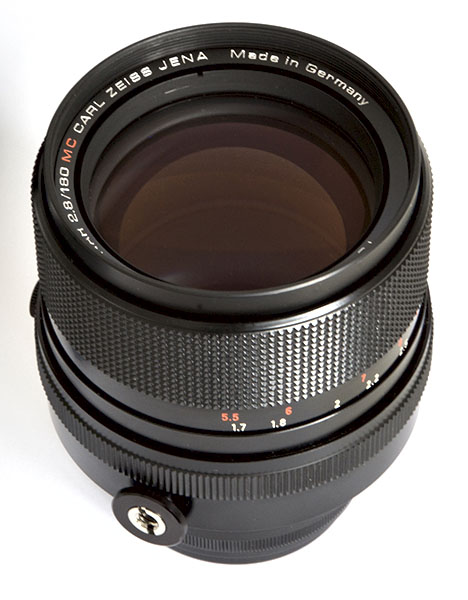 [gm180_05.jpg] All references to the “DDR” have gone! Either the East German state
no longer existed, having reunified with former
West Germany, or the communist politicians and
bureaucrats were observing the dictatorship that
they had established collapse around them.
|
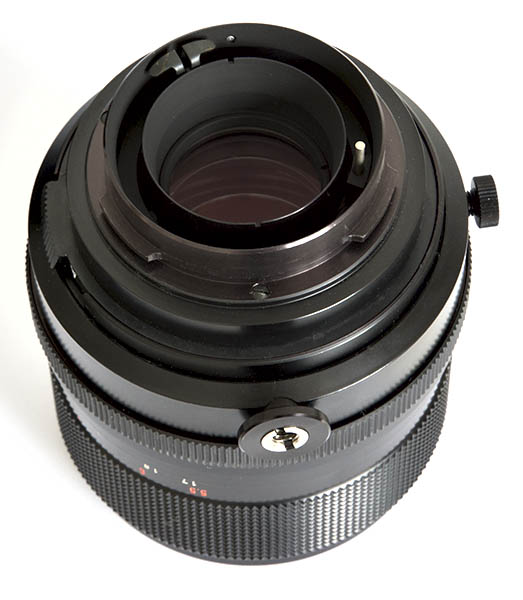 [gm180_08.jpg] Rear view of the same lens Note at “11 o'clock” position
the fork that engaged with a lever within the
Pentacon Six to Praktica LLC/PLC/VLC/EE 35mm
camera adapter, to transfer the aperture value
to the metering system within those cameras and
thus permit open-aperture metering.
|
|
Meyer-Optik Görlitz lenses
The Hugo Meyer Optische und Feinmechanische Werke was founded (with a slightly different name) in Görlitz in 1896 and over many decades it supplied lenses to many camera manufacturers throughout Germany. After the end of World War II it was mostly limited to supplying lenses for East German cameras, since Görlitz was in the Soviet-occupied sector of Germany that became the “GDR”. In 1946 the company was nationalised and became “VEB Feinoptisches Werk Görlitz”, although the name “Meyer-Optik Görlitz” continued to appear on many of the lenses that it manufactured.
In 1968 Meyer-Optik was absorbed into the large State-owned company “Kombinat VEB Pentacon Dresden”, and from 1971 the name Meyer no longer appeared on the lenses that it produced. Literature produced at the time by Pentacon said that the lenses would be called “Pentaconar”, although in fact the name engraved on the lenses from this point on was “Pentacon”, and from 1979 this was replaced by the name “Prakticar” on many lenses produced by the former Meyer-Optik. Needless to say, these lenses were also marked with the letters “DDR”.
In 1990 when the whole communist political, economic and manufacturing structure collapsed, the company became “Feinoptische Werk Görlitz GmbH”. Unfortunately, it appears to have produced lenses under this name for little more than a year. Here we shall see two Meyer-Optik lenses from that time, marked “Made in Germany”.
The two Meyer-Optik lenses that were produced for many decades for the Pentacon Six were the 300mm and 500mm pre-set lenses that were for a large part of this time labelled “Pentacon”.
| The
500mm “Pentacon”
lens To the right we can see in each picture a 500mm “PENTACON” lens in Pentacon Six mount, and to the right of it, the equivalent lens labelled “MEYER-OPTIK”. The second image shows the other side of these lenses. The “Pentacon” lens, on the left in the picture, is labelled “German Democratic Republic” in full and in English, while the “Meyer-Optik” lens to the right of it is labelled “Made in Germany”. Below we can see a close-up of the names on the two lenses.  [gm500_03n.jpg]  [gm500_04n.jpg] |
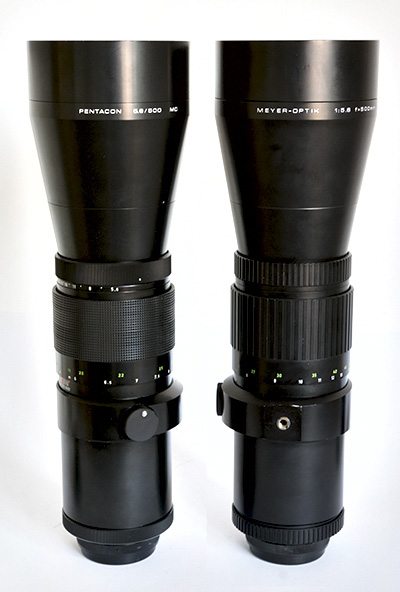 [gm500_03.jpg] |
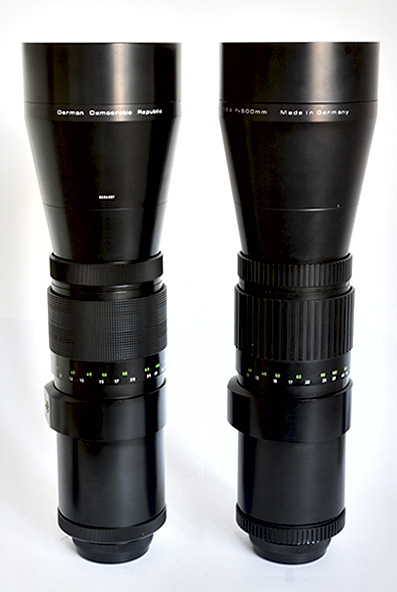 [gm500_04.jpg] |
| The
300mm
“Pentacon”
lens Here we see two views of the 300mm pre-set lens bearing the name “MEYER-OPTIK” and the designation “Made in Germany”. 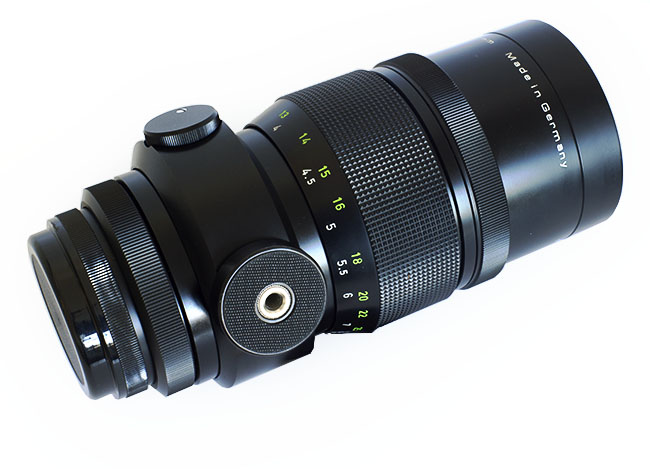 [gm300_02.jpg] |
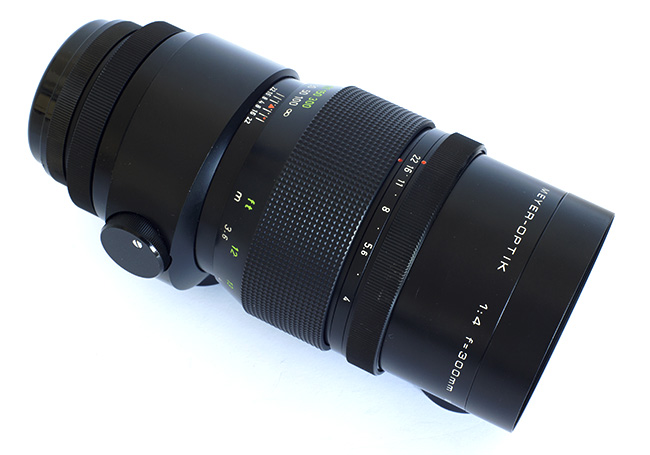 [gm300_01.jpg]
|
||||
| The manufacturing quality is superb, and the large, contoured base for the tripod is a great improvement on what is seen on many lenses (including some from Zeiss), where the base is in some cases far too small and likely to slip on the tripod. This one will grip in place, preventing unwanted swivelling of the lens. | |||||
|
|||||
